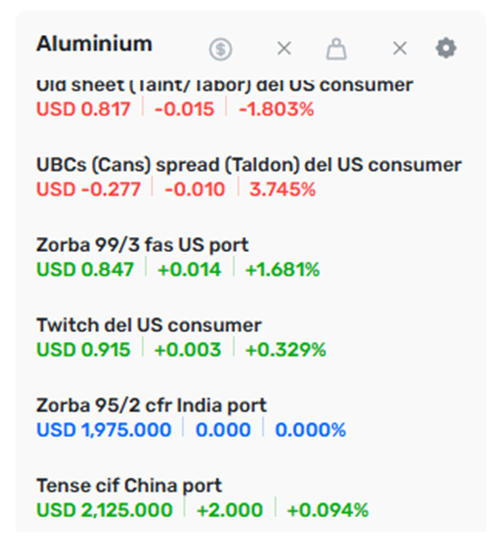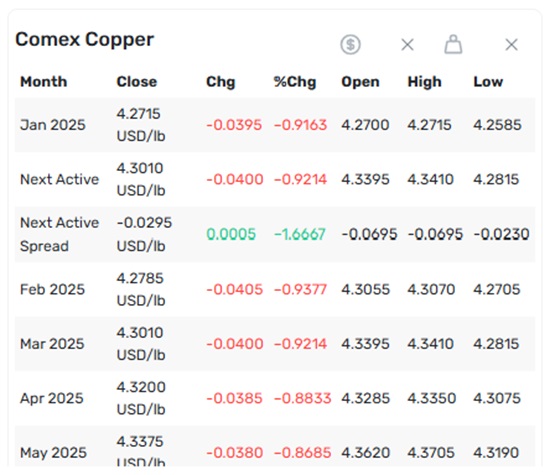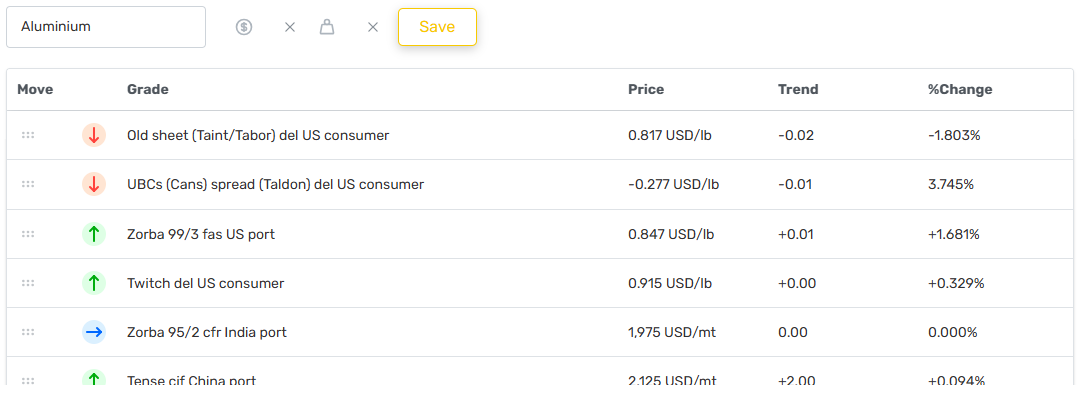Provides price benchmarks for recycled materials base metals, steel, stainless steel, and alloys backed by comprehensive market intelligence, news, and analysis.
Stay ahead with daily scrap metal market prices
Unlock the power of precision with unmatched price benchmarks for recycled materials, base metals, steel, stainless steel, and alloys backed by comprehensive market intelligence, news, and analysis.
Over 1,400 price indexes
Understand market dynamics
Negotiate better margins
Stay ahead with live pricing
The scrap metal pricing tool includes:
Scrap metal prices
Assess and Enhance Your Scrap Business Reputation
All scrap buying and selling companies can be evaluated on our Tradefox platform for their reliability and trustworthiness. Our company ratings are sourced from verified Tradefox members, ensuring that all reviews are 100% authentic and genuine.
We encourage a transparent assessment of a company’s reliability using our straightforward 1 to 5 rating scale. This reputation management system empowers businesses and stakeholders to make informed decisions based on credible feedback from the scrap industry community.
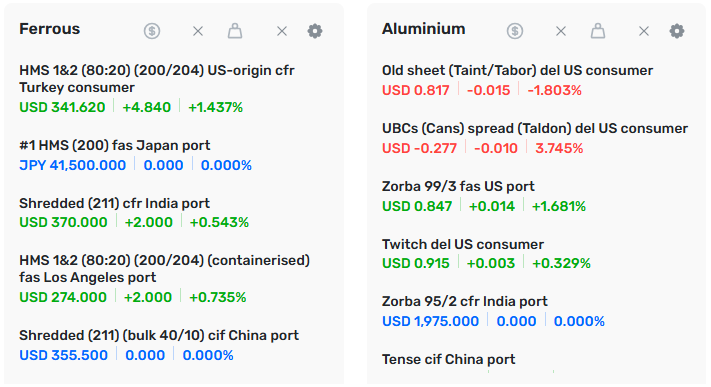

Industry Reputation
Assess and Enhance Your Scrap Business Reputation
All scrap buying and selling companies can be evaluated on our Tradefox platform for their reliability and trustworthiness. Our company ratings are sourced from verified Tradefox members, ensuring that all reviews are 100% authentic and genuine.
We encourage a transparent assessment of a company’s reliability using our straightforward 1 to 5 rating scale. This reputation management system empowers businesses and stakeholders to make informed decisions based on credible feedback from the scrap industry community.
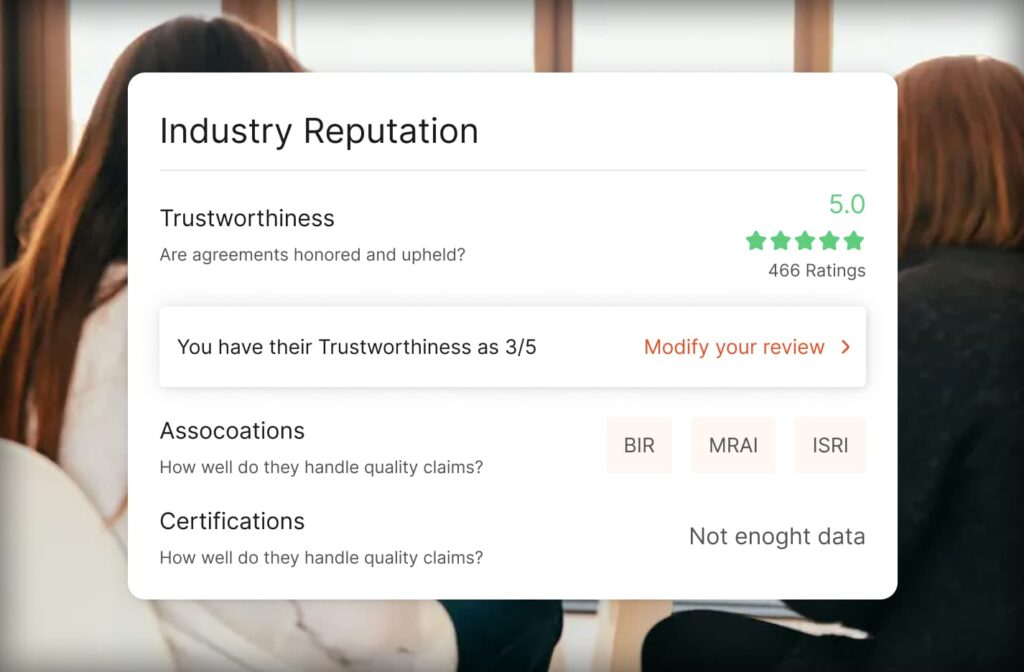

Trade Feedback
Trade Feedback is an essential component of our scrap Know Your Customer (KYC) reports, delivering critical data on key aspects necessary for business partnerships and collaborations. By integrating Trade Feedback with Trade Activity data, our platform provides a reputation management and risk assessment tool, supporting thorough due diligence processes.
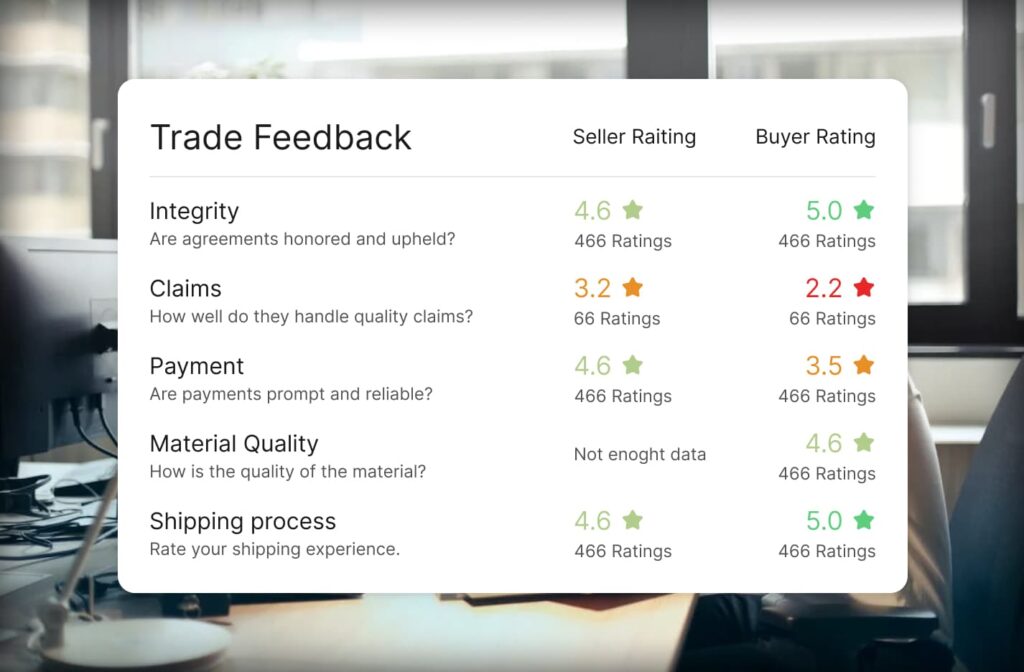

Trade Activity
Trade Activity is a crucial component of our scrap Know Your Customer (KYC) reports. It showcases a company’s monthly sales volume and trading figures, providing valuable insights into the company’s operational activity levels, which are strong indicators of its overall financial health and reliability.
When combined with the Top 5 Trading Partners section, the effectiveness of Trade Activity is significantly amplified. The Top 5 Trading Partners section highlights the primary companies a business engages with, detailing transaction frequencies and their share of trade volume. This integration offers a reliable metric for identifying new trustworthy connections and strategic business relationships.
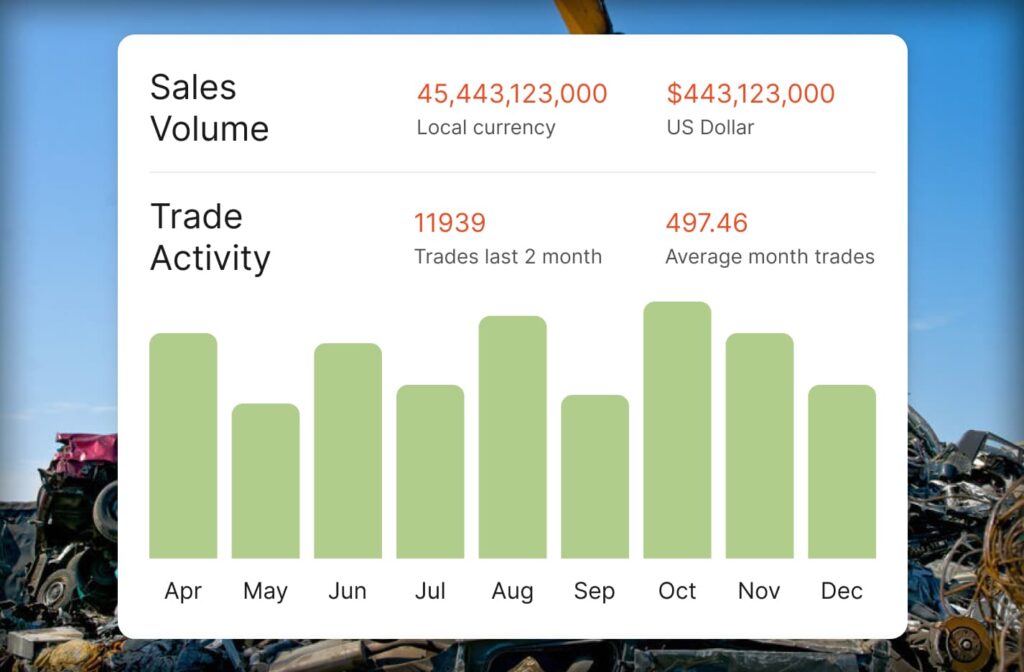

Top 5 Trading Partners
The Top 5 Trading Partners section is a highly valued feature of our scrap KYC (Know Your Customer) reports, showcasing the primary companies a business engages with, their transaction volumes, and their proportion of total trade activity.
You can also easily navigate to any of the top 5 trading partners to evaluate their performance in these areas, providing a view of their business reliability and trade history.
Combining this data with Trade Activity and Trade Feedback enhances overall business intelligence. Together, they offer a comprehensive analysis that aids in making informed decisions.
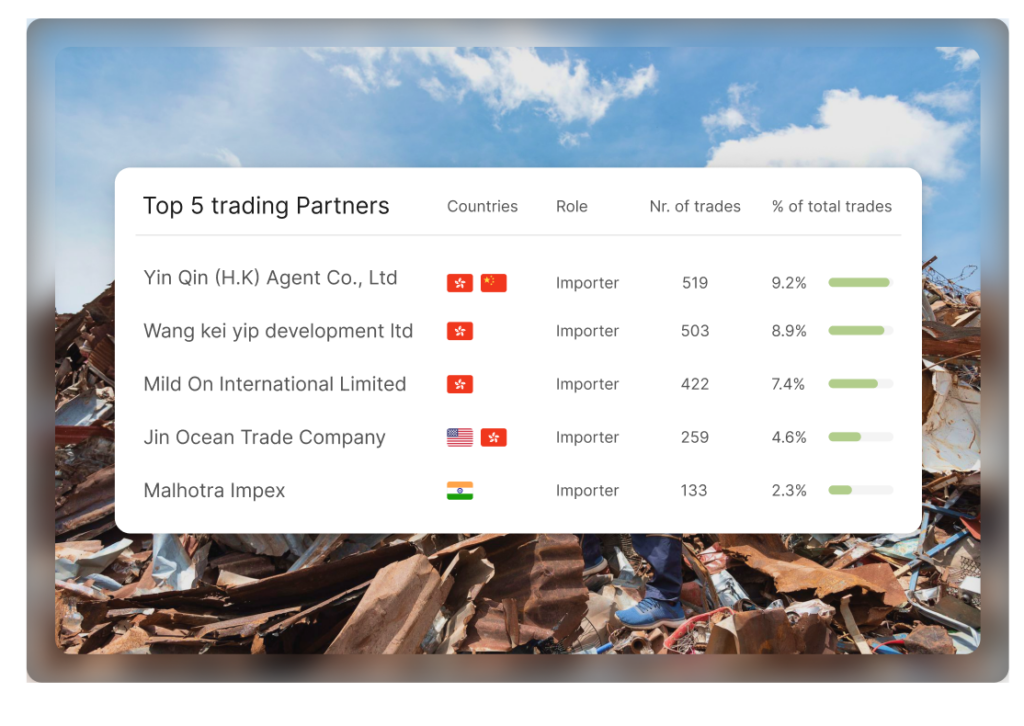

Gain instant access to scrap metal prices
Request contact with a specialist

Your information is safe with us and will only be used for personal contact.
Why register?
Access the pricing indexes in 3 steps
Sign up or Log in on Tradefox
Open the "Market Pricing" page
Subscribe to real-time market pricing


These industry leaders trust Tradefox
for their due diligence







Empower Your Scrap Trading Decisions
Experience the Power of Website Development: Unleash Your Online Potential
A well-developed website is crucial for establishing a solid online presence in today’s digital landscape. At Greatives, we understand the significance of creating captivating and functional websites that drive tangible results. A well-developed website is crucial for establishing a solid online presence in today’s digital landscape. At Greatives, we understand the significance of creating captivating and functional websites that drive tangible results. A well-developed website is crucial for establishing a solid online presence in today’s digital landscape. At Greatives, we understand the significance of creating captivating and functional websites that drive tangible results. A well-developed website is crucial for establishing a solid online presence in today’s digital landscape. At Greatives, we understand the significance of creating captivating and functional websites that drive tangible results.
Frequently Asked Questions
What pricing data can I access through Tradefox?
Through Tradefox’s partnership, you get access to:
- Live market prices from major exchanges (LME, CME)
- Global scrap metal price benchmarks
- Base metals pricing data
- Steel and stainless steel indices
- Price data for various alloys and specialty metals
How much does market pricing access cost?
Tradefox members can access live market pricing for just $600 plus transaction fee per year, representing significant savings compared to standard market rates.
Which regions are covered in the pricing data?
The pricing data covers:
- North American markets
- European markets
- East Asian markets
- South Asian markets
- Other relevant regions
How can I use this pricing data in my business?
The pricing data helps you:
- Make informed trading decisions
- Track market trends
- Price materials accurately
- Validate contract prices
- Monitor import/export opportunities
- Support negotiations
How current is the pricing data?
You receive:
- Real-time exchange prices
- Daily market updates
- Latest port pricing
- Current regional benchmarks
- Regular market trend updates
Can I try the pricing service before subscribing?
Contact your Tradefox representative to discuss trial options and see a demo of the pricing platform on this page.
Scrap metal prices
Scrap metal prices play a critical role in the global recycling industry. They represent the current market value of various discarded metals such as copper, aluminium, steel, brass and more. These prices fluctuate frequently because of international demand, economic trends, raw material shortages, and even geopolitical conditions. Whether you’re an importer, exporter, recycler or end-user, staying updated on scrap metal prices is essential to making smart trade decisions and protecting your margins. That’s why professionals across the globe monitor price changes closely, right from the beginning of each trade negotiation to final delivery. Scrap metal prices affect every link in the supply chain, from the scrapyard to the smelter and beyond, so understanding them from the outset is key.
The term “scrap prices” refers to the amount a buyer is willing to pay for recyclable metal at any given time. These values are not fixed they’re shaped by numerous external factors like supply and demand imbalances, currency fluctuations, regional policies, energy costs and industrial output. For example, copper scrap often surges in value when global construction activity or electronics manufacturing picks up, because both industries rely heavily on copper components. Aluminium, on the other hand, may rise in price when energy costs spike, since it’s energy-intensive to produce.
Unlike primary commodities traded on futures markets, scrap prices are also affected by quality and logistics. Cleaner, purer scrap with consistent chemistry will fetch a better price than mixed or contaminated loads. Transport costs, trade restrictions and the reliability of the trading partner also matter. This means even within the same material category, prices can vary greatly.
Copper scrap price
Copper remains the most valuable material in the world of scrap metal prices, consistently attracting high returns due to its essential role in construction, power grids, electronics and electric vehicles. Copper scrap prices fluctuate based on global infrastructure demand, mining output, and energy costs, so traders need to monitor them closely. Bare bright copper wire, clean and uncoated commands the highest prices, while mixed or insulated scrap typically trades lower due to extra processing requirements. Because pricing is also affected by location, logistics, and supply chain delays, the smartest traders look beyond surface rates. Tradefox users gain a clear advantage by viewing real-time copper prices alongside verified trade reviews and supplier histories, helping them spot reliable deals, avoid overpaying, and reduce risk. In today’s unpredictable metals market, knowing who you’re buying from is just as critical as knowing the scrap prices themselves.
Copper wire scrap price
Among all copper grades, wire scrap, especially bare bright copper wire is the most valuable and sought-after category in scrap metal prices. Because it’s pure, unalloyed, and easy to recycle, the copper wire scrap price often sets the benchmark for high-grade copper in the market. Clean, stripped wire without insulation consistently commands top-tier rates, while insulated or mixed wire trades lower due to the labor and cost of separating materials. Price fluctuations are driven by copper futures, industrial demand, and scrap supply from construction and electrical sectors. Even small batches of bare bright wire can deliver significant returns if sourced clean and sorted properly.
Aluminium scrap price
Aluminium plays a large role in global trade and is a core category in scrap metal prices because of its lightweight properties and broad industrial use. It’s found in everything from beverage cans and window frames to aircraft parts and automotive components, making it one of the most commonly recycled metals worldwide. The aluminium scrap price is influenced by global energy prices, transportation costs, and regional recycling demand, especially in sectors like packaging and construction. Clean aluminium scrap, such as extrusions or sheet scrap, typically trades higher than painted or mixed grades that require more processing. Because pricing can vary significantly by region and scrap type, buyers and sellers need reliable reference points to negotiate fairly. On Tradefox, users can monitor current aluminium scrap trends and compare offers with supplier reputation data and peer reviews, so they don’t just chase low scrap prices, but also build safer, more profitable trading relationships.
Stainless steel scrap price
Stainless steel is a high-demand material in the scrap metal prices landscape because it combines durability, corrosion resistance, and value, especially in industrial and manufacturing sectors. Its pricing is largely tied to the global cost of its core components, such as nickel and chromium, which can fluctuate based on mining output, geopolitical shifts, and manufacturing cycles. The stainless steel scrap price varies by grade, with 304 and 316 types being the most valuable due to their higher alloy content. Clean, uncontaminated stainless scrap commands better rates than mixed or dirty loads that need reprocessing. As infrastructure projects and stainless-heavy industries grow, so does interest in this category of scrap. Tradefox users benefit from more than just a number, they get real-time pricing data paired with company ratings and past trade insights, helping them evaluate not just competitive scrap prices, but also the trustworthiness of trading partners offering them.
Brass scrap price
Brass holds a steady position in the hierarchy of scrap metal prices, thanks to its durability, recyclability, and widespread use in plumbing, electrical components, fixtures, and decorative items. Made primarily from copper and zinc, the brass scrap price often moves in line with copper markets, though it’s generally lower due to alloying and contamination levels. Yellow brass, which is common in valves and fittings, typically commands higher prices than mixed or dirty brass, which may contain coatings or residues. Market demand from construction and manufacturing sectors also influences pricing, as does the availability of clean, sorted material. Since brass often appears in older infrastructure and consumer goods, its recovery potential is high, but valuation depends on both grade and source. On Tradefox, users can track current brass scrap prices and review counterparties before closing deals, combining up-to-date market intelligence with trust-based insights to minimize risk and maximize return.
Steel scrap price
Steel remains one of the most traded commodities globally, and its role in scrap metal prices is both dominant and complex. As a key raw material for construction, automotive production, and heavy machinery, the steel scrap price is highly sensitive to shifts in industrial activity, energy costs, and global trade flows. Prices are also influenced by steel mill demand, scrap availability, and regulatory changes, especially export controls or tariffs in major regions. While ferrous scrap generally trades at lower values than non-ferrous metals like copper or aluminium, its sheer volume makes it a cornerstone of the recycling economy. Clean, sorted grades such as HMS (Heavy Melting Steel) or shredded scrap are priced higher than mixed or contaminated batches. Tradefox helps users stay competitive by providing current steel scrap prices along with peer-reviewed insights into supplier reliability, so decisions are made with clarity, not just cost in mind.
Iron scrap prices
Iron is one of the most recycled materials on the planet, forming a significant part of global scrap metal prices due to its abundance and demand in construction, automotive manufacturing, and infrastructure. The iron scrap price tends to follow trends in the steel market, but it’s typically priced lower because of its lower alloy content and broader availability. Factors like industrial output, energy costs, and shipping logistics all influence price movements, while regional policies, such as export restrictions can create temporary spikes or dips. Clean, heavy iron scrap fetches better rates than mixed or rusted material, and bulk loads often benefit from more favorable pricing.
Lead scrap price
Lead plays a specialized yet important role in the ecosystem of scrap metal prices, particularly because of its applications in batteries, roofing materials, radiation shielding, and certain industrial products. The lead scrap price is influenced by global battery recycling programs, regulatory policies on hazardous materials, and the supply of lead-acid batteries entering the scrap stream. Prices for clean lead scrap, such as battery plates or soft lead sheeting are higher than those for mixed or contaminated loads, which require more intensive processing and safe handling. Because of its toxic nature, lead recycling is strictly regulated in many regions, affecting both availability and trade dynamics.
Cast iron scrap price
Cast iron holds a distinct place within scrap metal prices due to its high density and frequent use in heavy-duty components like engines, machinery, manhole covers, and cookware. The cast iron scrap price is generally lower than other ferrous metals because cast iron is brittle, harder to process, and often mixed with other materials that reduce its resale value. However, its weight means even low prices can yield strong returns when traded in volume. Pricing is influenced by local foundry demand, global steel production, and transportation costs, since cast iron is heavy and less compact logistics play a larger role in profitability. Clean, unpainted cast iron typically sells better than coated or composite materials.
How Tradefox helps users track scrap metal prices
Tradefox offers a purpose-built platform that helps professionals navigate the fast-moving world of scrap metal prices. On our Scrap Metal Market Prices page, users get instant access to accurate price data curated from trusted global sources, including Davis Index. But we don’t stop at just showing prices, we provide critical context through verified trading behavior and peer reviews.
Because Tradefox tracks actual company performance and counterparty risk, our users can assess whether a deal is worth pursuing beyond just the numbers. For example, if a seller offers a great rate on shredded aluminium but has a history of delayed shipments or questionable cargo quality, that’s something you’ll see upfront. This combination of market insight and reputation intelligence sets us apart.
So while other platforms show numbers, Tradefox helps you interpret them in the real-world context of international trade.
